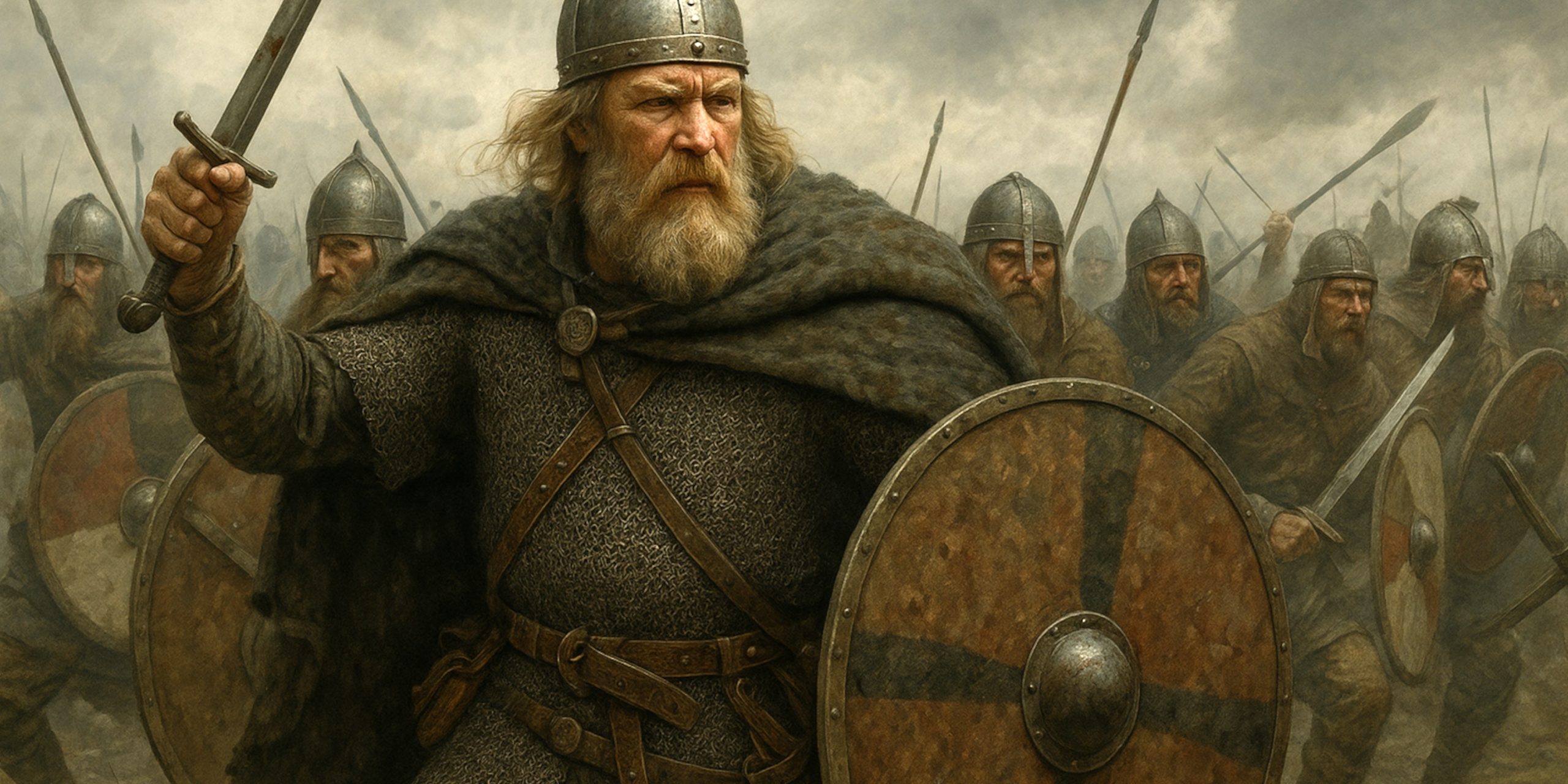
Harald “Bluetooth” Gormsson, king of Denmark and parts of Norway in the late 10th century, remains one of the most prominent early Scandinavian rulers. His reign marked a critical transitional period from pagan Viking traditions to Christianity and from fragmented chieftain-led regions to more centralised rule. He is best remembered for unifying Denmark and introducing Christianity, though the reality of his rule is more complex and deeply tied to military strength, political adaptability, and religious pragmatism.
Historical Background
Harald was the son of King Gorm the Old and Queen Thyra. He assumed the throne after his father’s death around 958 and ruled until approximately 985 or 986, when he was forced into exile by his own son, Sweyn Forkbeard. Harald’s nickname, “Bluetooth,” is still debated. Some theories suggest it refers to a dead tooth, while others point to symbolic meanings of unification, later appropriated by modern Bluetooth technology.
Arms and Armour
Harald’s period sits at the tail end of the Viking Age. The weapons and armour associated with his time were both functional and ceremonial, reflecting a warrior elite closely tied to status and loyalty.
Common Weaponry:
- Swords: Double-edged, pattern-welded blades with simple guards and ornate pommels. Swords like the Petersen Type S or T were in use during his reign.
- Axes: From standard broad axes to the more lethal Danish long-handled axes, often used by elite warriors.
- Spears: The most common battlefield weapon, often used in conjunction with round shields.
- Bows: Primarily used for hunting, though also present in warfare.
Armour and Protection:
- Mail shirts: Worn by wealthier warriors. Chainmail was rare and expensive but increasingly accessible among Harald’s retinue.
- Helmets: Iron helmets with rounded or conical shapes, sometimes with spectacle guards. Horned helmets are a myth from later centuries.
- Shields: Wooden round shields with iron bosses, sometimes painted and rimmed with leather or iron.
Battles and Military Acumen
Harald’s reign was marked more by strategic consolidation and defensive construction than by raiding or large-scale expansion. However, he did engage in critical conflicts.
Key Military Events:
- The Unification of Denmark: Through a mix of force, alliance, and religious conversion, Harald brought various regional chieftains under his rule.
- Conflict with Otto I: Around 974, Harald was defeated by forces of the Holy Roman Emperor Otto I, losing territory in Southern Jutland. This episode illustrates Harald’s limitations in external military campaigning but also his resilience, as he regained control in the early 980s.
- Norwegian Campaigns: Harald briefly controlled parts of Norway, though this hold was unstable and contested. His authority likely stemmed more from influence over key Norwegian lords than from direct rule.
- Defensive Engineering: His military focus included major fortification efforts such as the construction of the Trelleborg ring fortresses, reflecting central planning, military preparedness, and logistical control.
These fortresses were circular with standardised gates, ramparts, and internal structures, likely used to house and train royal troops. Their precision suggests Harald was aiming for long-term territorial stability rather than opportunistic plunder.
Where to See Artefacts from Harald’s Reign
A number of significant artefacts and structures from Harald Bluetooth’s reign survive, offering insight into his power, religious conversion, and military planning.
Notable Sites and Artefacts:
- Jelling Stones (Jutland, Denmark): The most famous monument of Harald’s reign. One stone proclaims Harald’s achievements: “Harald who won all of Denmark and Norway and made the Danes Christian.” This runestone is considered Denmark’s ‘birth certificate’.
- Trelleborg Fortresses: Found in locations such as Slagelse, Aggersborg, Fyrkat, and Nonnebakken. These military sites were built to a standardised plan, likely by royal decree.
- National Museum of Denmark (Copenhagen): Hosts a wide range of Viking Age artefacts, including weapons, tools, jewellery, and items linked to Harald’s reign.
- Birka and Hedeby: While not directly associated with Harald himself, these trade towns flourished under the broader framework of Viking commerce and royal control during his lifetime.
Archaeological Findings
Ongoing excavations have continued to shed light on the scope of Harald’s projects and the evolution of his rule.
- Bluetooth Fortresses: Recent digs have revealed more about how the ring fortresses were constructed and populated. Evidence of standardised building layouts suggests an organised, possibly centralised command structure.
- Christian Symbols: Burials and artefacts from the late 10th century increasingly feature crosses and Christian motifs, suggesting a shift in religious practice that Harald encouraged or mandated.
- Hoard Discoveries: Coin hoards, including both Islamic dirhams and Carolingian coins, have been found in Denmark, illustrating long-range trade and tribute flows during Harald’s reign.
In 2022, a hoard uncovered on the island of Funen was linked to the period shortly after Harald’s death, with suggestions it was buried by loyalists during Sweyn Forkbeard’s rebellion.
Legacy
Harald Bluetooth’s reputation balances between a pragmatic ruler and a transitional monarch. He did not embody the ferocious Viking raider archetype but instead focused on unification, religious transformation, and the infrastructure of kingship. His Christianisation of Denmark, however politically motivated, laid the groundwork for its integration into wider European Christendom.
His legacy persists not only in monuments and archaeology but also in the modern era through the naming of Bluetooth technology, symbolising communication and unification, both central to Harald’s historical role.
Watch the documentary:



